| |
|
 LuBan Master Caftsmen and Inventor  |
|
| Lu Ban (魯班) lived from about
507–444 BC. BC and was a Chinese builder, inventor
and carpenter during the Zhou Dynasty. He is revered
as the Daoist patron saint of architects, building
contractors and carpenters. Lu Ban was born in the historical state of Lu. This corresponds approximately to today's QuFu in ShanDong. QuFu is the birthplace of Confucius (551-479 B.C.E.) and with its historic city complex, its palace of imperial dimensions, the tomb and the residential complex of the dukes of the Confucius descendants, it is a first-class sightseeing destination. QuFu adorns itself among other things with the title 'Hometown of Lu Ban'. On May 1st, 2016, the almost 100 ha large 'QuFu Lu-Ban Park' was opened. The park houses a LuBan hall, a LuBan museum, a LuBan square and also the LuBan Research Institute. |
|
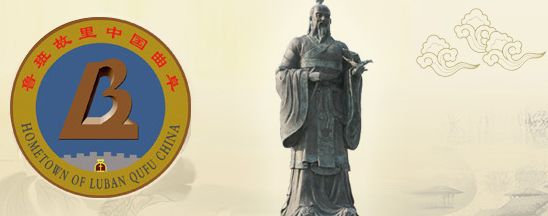 Click on Picture! |
|
| Some sources
claim that LuBan was born far to the west in DunHuang,
during the spring and autumn periods of the Zhou Dynasty
as a son of a family of artisans. His original name was
GongShu YiZhi (公 输 依 智). Other names are GongShu Ban (公
输 班) or GongShu Pan (公 輸 盤). In Cantonese he is named Lo
Pan (魯 盤). |
|
| LuBan was
considered a less attentive student, until his love of
learning was sparked by the scholar ZiXia (子夏), a disciple
of Confucius. He later on learned wood working from Master
"BaoLaoDong". His technical work was highly valued. It's
said, that the great demand for his work allegedly forced
him to invent or improve a range of carpentry tools,
including stop angles, planes, drills, shovels and a
self-marking plumb line to complete his many projects
faster. His wife LuMei (鲁美) was
credited with inventing the umbrella so that he could work
even in bad weather. |
|
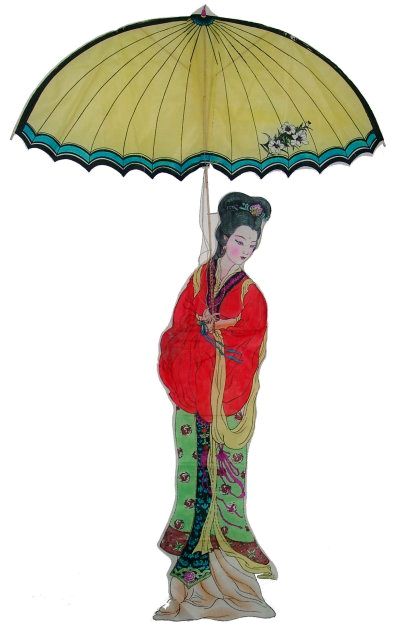 Click on Picture! |
|
| There is a
legend about the invention of the saw. The story goes,
that when LuBan grabbed a tree trunk to climb a steep
slope while collecting firewood, he was cut from a
serrated tree-leaf margin. He realized that the
structure of the leaf margin could be an efficient tool
for sawing and cutting trees. He is also credited with inventions for classical warfare: for example the so-called 'cloud ladder' for climbing fortress walls, an improved rope ladder, a mobile siege ladder with counterweight, a specially shaped gripping hook for climbing fortress walls and a so-called 'ram' (battering ram) as well as other siege tools and devices for naval warfare. There is an extensive classic literature from the 3rd to 15th centuries that celebrates his inventions. |
|
| The invention of
the 'Wooden Bird' was
attributed to him, and this is probably the most
important invention for the kiting realms. The 'Wooden Bird' is considered the
prototype of a kite that, as described,
"could stay in the air for three days". An occasionally
reported story describes how LuBan, after inventing the
woodworking planer, removed some large and flat wooden
chippings. At the moment of falling, the workshop door
was opened by his wife. The resulting draft caused the
flat wooden chips to slowly sail down from the
workbench. He tried to fathom this phenomenon and then
developed the 'wooden bird' as a kite prototype. In
front of the 'Kite Museum of WeiFang' is a
larger-than-life statue of LuBan. |
|
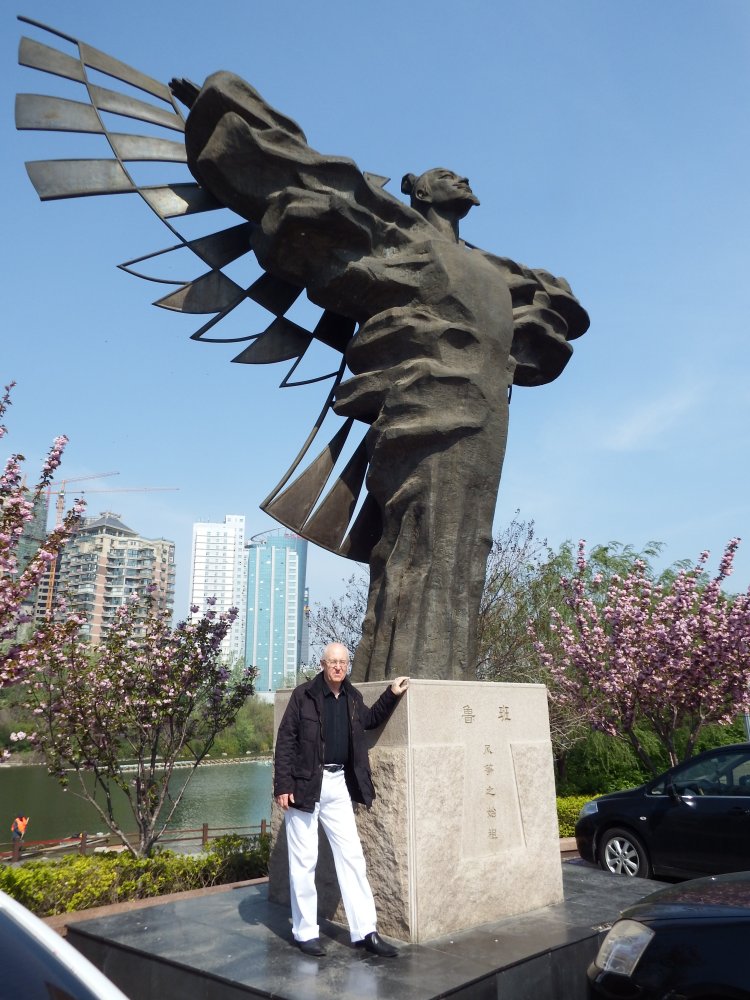 Lu Ban Monument in front of the WeiFang Kite Museum (2015) |
|
| LuBan
Shrine in BeiJing Some of LuBan's inventions are exhibited in the 'China Science and Technology Museum'. The museum is located not far from the central Olympic site of 2008. The museum itself also contains cult objects from the LuBan shrine of BeiJing. The Daoist shrine itself is housed in a neighbouring courtyard of the temple, and is only accessible upon request from the temple administration of the DongYue Temple (Dōng YuèMiào, 东岳庙). DongYue Temple is BeiJing's largest Daoist temple complex. The DongYue Temple gives a very evocative and detailed overview of Daoist ideas, including good English-language explanations. There is even a section on the 'Wind Gods', very important for kiters. The temple complex also houses the 'DongYue Miao BeiJing Folk Arts Museum', which also had a small exhibition on historical kites and kiting in former times. |
|
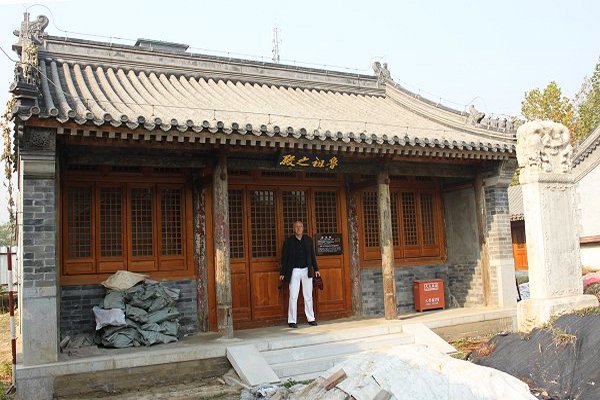 LuBan Shrine in BeiJing (2011) Click to see the "LuBan Temple Stele"! (Only the upper part of the stele is readable "Lu Ban Ancestor-Hall") (All cult objects have been moved to the 'China Science and Technology Museum' of BeiJing) |
|
| LuBan
Shrine HongKong LuBan is revered in the Chinese folk religion as the patron saint of carpenters and masonry. Consequently, he is also the patron saint of architects. The LuBan Shrine in Hong Kong is co-managed by the university's architecture department. The shrine is at the back of the architecture campus, but can only be reached via Kennedy Road and a steep lane via 'Ching Lin Terrace'. Be sure to reach there when the shrine warden is in attendance. |
|
 Clic on pic for internal view of the shrine! Lu Ban can be found in many even smaller Daoist temples, dedicated to other deities. Temple Street in Hong Kong's KowLoon District is often visited for it's night market. At the northern end is the "Yaumatei Tin Hau Temple" (油麻地天后廟). In the multitude of it's shrines, you may inside spot the Saint Master Lu Ban. |
|
| LuBan
Shrine in Macao The LuBan Shrine in Macau on the 'Rua Da Cal' is owned by the 'Builders Guild of Macao'. Every year at LuBan’s birthday on the 13th day of the sixth month of each lunar year, there is a big temple fair. Another place of worship for Lu Ban is located on Coloane (Macao's most southern island) at 'Largo Tin Hou Miu'. There is a TianHou shrine that houses a small temple niche of LuBan. Those who make the effort to go to Coloane should not be missed to dine in the central patio of the village, and visit the 'Capela de Sao Francisco Xavier'. Just have a sip of a good sangria, and a good portion of gambas at 'Nga Tim'. In the early evening next door to the chapel you may enjoy a happy meal. The patron may also sing to the guitar when he and the guests are happily tipsy. |
|
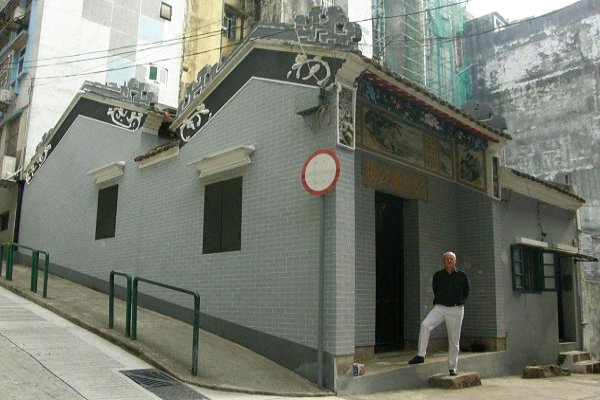 Lu Ban Shrine in Macao (2011) |
 tempel warden tending shrine 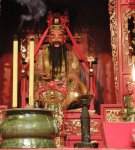 details of the shrine  together with spokeswoman of 'Builders Guild of Macao' Click on small pictures to enlarge! |
| LuBan
Shrine in TianJin The Lu Ban shrine in TianJin originally belonged to the DuLeSi temple complex (China, Tianjin, Jizhou) in the back end of the 'WuDing Pedestian Street' (武 定 步行 街). The temple district is no longer a closed building area due to a variety of historic developments. The DuLeSi was built in the Sui Dynasty (581-612). It houses a 16m high wooden GuanYin statue with 11 crowned heads, and is unique in this form. The main hall is one of the oldest wooden structures in China and has survived 28 earthquakes. The Lu Ban shrine is now outside the DuLeSi complex on FuHou Jie. The temple servant told us about the extensive restoration work and the venerable history of the temple, which was rebuilt in the early Qing period. There is a report about the Lu Ban shrine in an Air China Air passenger magazine. Another attraction in the neighbourhood of the LuBan shrine is the Temple of the 'White Pagoda' (1048, Liao period). The LuBan temple is a purely Daoist shrine. As described above, it originally belonged to DuLeSi. The DuLeSi is a Buddhist temple of the Chan tradition. Blending of beliefs are often found in popular religions. |
|
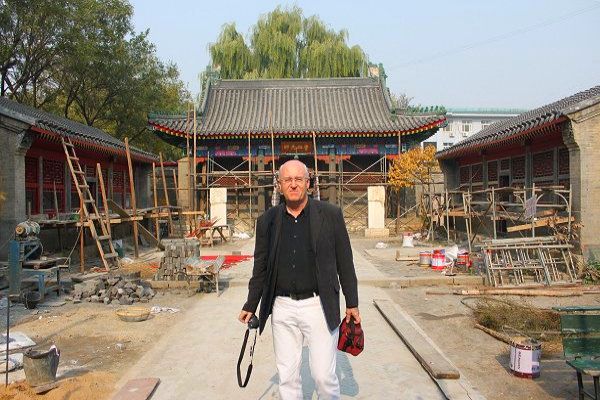 |
 |
| Lu Ban Shrine TianJin
(2010) (Renoviation) Click pic for interior view! |
Lu Ban Shrine TianJin
(2010), Entrance to Main Hall Click pic for picture prior to renovation (2008)! |
| LuBan
Shrine in TaiZhong There are also several shrines in TaiWan where Lu Ban is worshiped. The largest shrine is in TaiZhong, and can be reached in a half-day trip by express train and two local buses from TaiBei. We arrived late, but the shrine guard was still at dinner and his grandchildren were still doing schoolwork. As is customary in southern China, the temple is very richly decorated. The electronic ticker above the temple entrance irritated my taste of art. Within the temple, there are many niches with carvings and pictures of events from LuBan and some of his inventions are also depicted. The very friendly shrine warden gave me a red remembrance ribbon and a detailed brochure about the shrine. I always see the remembrance ribbon, when I enter my little kite museum. |
|
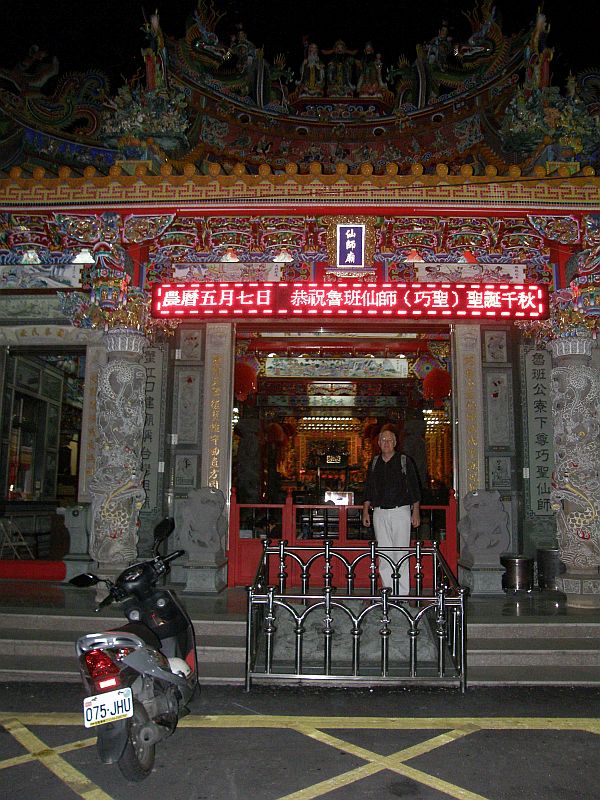 Click on pic for interior view! |
 Lu Ban Manifestations Click on pic for interior view! |
| Of course, there are many
more shrines, not only in China, but also in other
Southeast Asian countries. The largest shrine is said to
be in Vietnam at Hanoi. Lu Ban is also honored here
under the aspect as the prime kite inventor. The shrine
was unfortunately not yet on my itinerary, as well as
the Lu Ban Temple in Jakarta, Indonesia. Lu Ban is also the patron saint of shipbuilders, and is occasionally assigned to the "Five Kings of the Immortals of the Water World" within the Daoist context. He is therefore also considered to be the patron saint of seafarers and travelers. These aspects are also occasionally presented in these shrines. |
|
LuBan Association The Lu Ban Association (鲁班 关爱 协会, LǔBān GuānAi XiéHuì) is dedicated to research in the works of Lu Ban. Some members are affiliated with the aforementioned LuBan Research Institute of QuFu. |
|
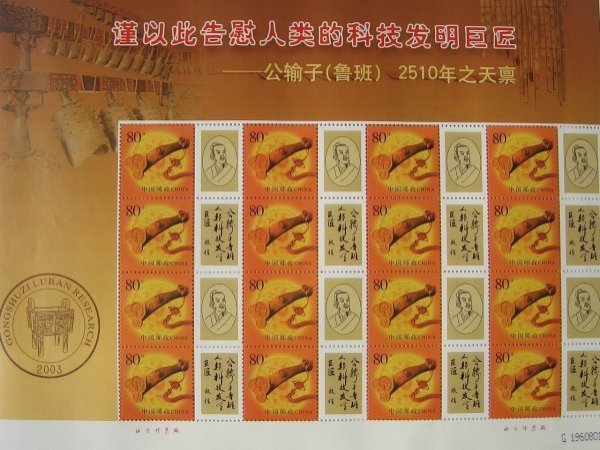 Commemorative stamp issue sheet of the Lu-Ban Research Society (2003) |
|
| In 2019, three
LuBan commemorative stamps were issued by the Chinese
postal administration. They show LuBan with a wooden
model of a Chinese pavillion, with a stonemason tool
(both at 1.20 yuan, miniature sheet) and with a wood
working planer (6 yuan, single stamp, small miniature
sheet) |
|
 |
 |
~~~~~~~~~~~~~~~~~~~~~~~~~~~~~~~~~~~~~~~~~~~~~~~~ |
|
| Take
a look at the kites at our Internet
Kite Exhibition, or meet us at the next kite
festival (a mouse click will show you where
to meet soon)! Every year we arrange kite festival trips to China. Just experience China and kite flying at the original venue. We are always welcome at the big Kite Olympics in China. Towards the end of April, the largest kite festivals on the Globe take place. The kite trips take us to WeiFang (middle / end of April) or QingDao and GuiYang (end of April / beginning of May) and ShenZhen, HongKong and GuangZhou (October). Of course, Beijing is always an option to go. After all, we want to fly our kites on Tiananmen Square or at the Temple of Heaven and on the Great Wall of China. |
|
|
Copyright 2020 ff:
Hans P. Boehme
|
|
